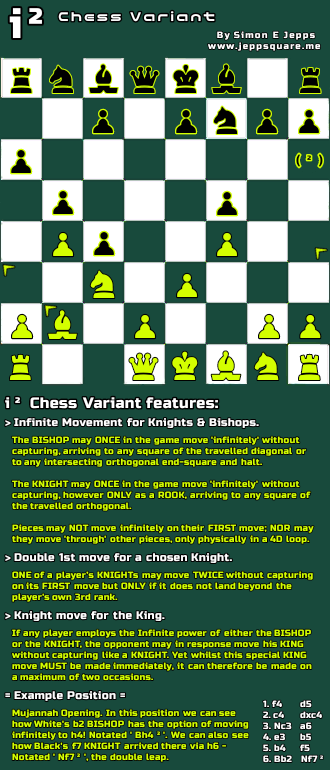i²
A Chess Variant By Simon Edward JeppsDownload ~ PDF ↷ ⋱ ⋱ Chatblog ⨗
How To Play
 i² is an 8x8 QwikVar played just like Classical Chess only featuring THREE additional rules which augment the game into a new dimension.
i² is an 8x8 QwikVar played just like Classical Chess only featuring THREE additional rules which augment the game into a new dimension.
One of these rules is a concept called Infinite Movement. This is a concept involving the ability of pieces to travel off the edge of the board and arrive to the opposite edge, as if travelling in a 4D loop.
Granted, the concept of Infinite Movement is seldom if ever used in Chess Variants and this is because it is an astronomical alteration to the methodical philosophy of the game.
In short it usually gets very confusing. But stay with me, for usually the confusion only arises whence granting most pieces this ability most of the time.
i² is very different and is designed to cradle, cherish and preserve the Classical philosophy of the game by only allowing Infinite Movement on a maximum of TWO occasions.
Yet moreover, in graceful conjunction with TWO other minor enhancements to the game, i² has nailed the beauty of this concept firmly into the ancient wooden grain of this legendary boardgame.
Infinite Movement for Knights & Bishops
The Bishop may ONCE in the game move Infinitely without capturing, arriving to any square of the travelled diagonal or to any intersecting orthogonal end-square and halt.The Knight may ONCE in the game move Infinitely without capturing, however ONLY as a Rook, arriving to any square of the travelled orthogonal. The Knight may NOT otherwise move orthogonally.
Pieces may NOT move Infinitely on their FIRST move; NOR may they move 'through' other pieces, only physically in a 4D loop.
Note: Infinite Movement is restricted to ONE move per Knight & Bishop ONCE in the game each. Thus once you have moved your Bishop or Knight Infinitely, that piece may NOT move Infinitely again for the rest of the game. Use them wisely.
Double 1st move for a chosen Knight
ONE of a player's Knights may move TWICE without capturing on its FIRST move but ONLY if it does not land beyond the player's own 3rd rank.Knight move for the King
If any player employs the Infinite power of either the Bishop or the Knight, the opponent may in response move his King without capturing like a Knight. Yet whilst this special King move MUST be made immediately, it can therefore be made on a maximum of TWO occasions.= Example Position =
1. f4 d5 2. c4 dxc4 3. Nc3 a6 4. e3 b5 5. b4 f5 6. Bb2 Nf7²Mujannah Opening
In this position we can see how White's b2 Bishop has the option of moving Infinitely to h4! Notated Bh4². We can also see how Black's f7 Knight arrived there via h6 - Notated Nf7², the double leap.
The reason the indicating arrows do not continue along the Infinite diagonal towards e7/d8 is because when a Bishop moves Infinitely to an intersecting orthogonal end-square it must halt on that end-square. Whereas only if travelling Infinitely along the same diagonal may it continue to any square.
Whilst not mentioned in the diagram, White's c3 Knight can also move Infinitely, herein arriving to h3, g3 or f3. Notated for example Ncg3². The Knight may NOT move orthogonally to d3, since that would not be Infinitely.
The superscript 'squared' suffix ( ² ) is used for all special moves in the i² variant. I decided this would be OK because the few special moves that exist in the variant are actually easily interpreted and distinguishable when reading through a game.
However, when notating Knights it is important that their origin square is given, like in the example from the diagram. This is because unlike Bishops, when notating Infinite Movement there can be confusion between whether or which an Infinitely Moving Knight or a Double Leaping Knight made the move.
Finally for example, if a player were to move his King like a Knight to say b3, thus in response to Infinite Movement by the opponent, this would be notated Kb3².
Alternative Gameplay
For the die-hard Classicalist, an alternative gameplay would be to allow Infinite Movement only ONCE in the game, of either the Bishop or Knight, each player making their own choice between the two. All other i² rules would remain the same. I like this idea myself, but made the official game a little more dynamic for entertainment purposes.Summary
I have been tinkering with the concept of Infinite Movement since the very beginning of my lifelong Chess Variant investigations.I think any artist or philosopher would agree that when looking at a Chess board it seems only natural to assume that there should be an evolution of the game that embraces such a concept.
Indeed though whilst people might like the idea of all and any piece moving Infinitely here, there and everywhere, it has been a generation-long subconscious project of mine to triangulate, target and engage with the elusive quantum anomaly hampering the realisation of Infinite Movement within the popular Classical setting.
Yet it is not only Infinite Movement which I have had a deep, longing connection for, but also the evolution of the Knight. I have written many times about how I feel the Knight needs to improve its 1st-move footprint beyond the mere K/QB3 square. Likewise, finding a classically embracing solution has also been a labour of love and yet, I do believe this simple 2-move rule for just one chosen Knight to be the very flavour of change the game requires.
Finally I should mention, the special King's Knight move is not just a reasonable relief for any player facing a scary surprise of Infinite proportions, but is in fact a salutation to ancient India, whence in times of despair a King could summon his one-time special power and move also, like a Knight.
Herewith, I hope with i² to have crafted a new version of Chess that appeals to every kind of player, from amateur, to club, through tournament and competition all the way to Grandmasters and perhaps... beyond.
In any case, I myself am very happy with the final work.
Thank you for reading.
Chatblog ⨗
 |  |





